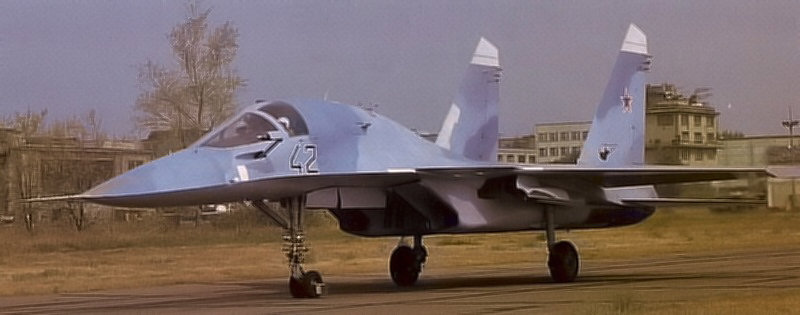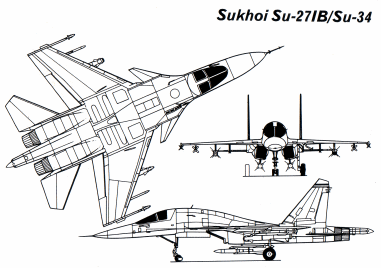A great deal of confusion exists even as to the proper designation of this two- seat Su-27 derivative. When the aircraft was displayed at Minsk-Maschulische (its first official unveiling) in a closed display for CIS leaders, an information board bore the designation Su-271B. However, until the 1993 Paris air show this designation was consistently denied and the alternative designation Su-27KU was used instead.
This muddle over designation is more significant than being mere semantics, since the two designations represent two very different roles. The first sight of the aircraft was afforded in a TASS photo released in August 1991, showing it on approach to the carrier Tbilisi, although it seemed to lack arrester hook and folding wings (as was later confirmed). Side-by-side seating, giving pilot and instructor the same approach picture, is of obvious benefit for a carrier training aircraft, as is the strengthened undercarriage with twin nosewheels, and the newly revealed designation KU (Korabel- nii Uchebno or, literally, shipborne trainer) would seem to support such a role, although the lack of arrester hook, wing and tailplane folding and the longer wheelbase would mitigate against naval use.

The Su-27IB was probably developed as a carrier-based training aircraft, but
the design has since been revised slightly to meet the Russian air forces'
requirement for an Su-24 replacement in the interdiction and strike roles.
The production version will be the Su-34.
The IB designation (Istrebitel Bombard- irovshchik or, literally, fighter-bomber) used at Minsk was supported by the aircraft's retractable inflight-refuelling probe (internal fuel would surely be adequate for carrier training) and (admittedly unlikely) load of bombs and air-to-surface missiles. With suitable sensors, the Su-27, with its excellent range and endurance, would make a commendable strike aircraft, and recent articles in the Russian press claim a titanium armoured cockpit, armoured glass and CRT displays. The intakes are also said to have been redesigned for higher speed at low level and the aircraft is reportedly optimised for 'contour-hugging' flight.
It seems likely that the aircraft was origi- nally developed as a two-seat carrier trainer but that changed circumstances have led to its consideration as a potential basis for an Su-24 replacement, and its use as a demonstrator for such an aircraft. This would explain the aircraft's lack of radar, IRST and sensors. The original KU designation may have been resurrected for political reasons.
Whatever the confusion over designation, the nickname 'Platypus' is universally recognised, leading from the flattened, slightly-upturned nose shape, whose chines make it reminiscent of the SR-71 nose. The Su-271B might form the basis of EW and recce variants of the Su-27. The production version, designated Su-34, is of similar configuration but has tandem twin main wheels and an extended, raised and enlarged tail sting.
SPECIFICATION
Sukhoi Su-27IB
 Generally similar to the Sukhoi Su-27 'Flanker-B' except
in the following particulars:
Generally similar to the Sukhoi Su-27 'Flanker-B' except
in the following particulars:
Powerplant:Two NPO Saturn (Lyul'ka, AL-31FM turbofans, each rated
at 130.42kN (29,320 lb st) with afterburning)
Weights:maximum take off 44,360 kg (97,795 lb)
Fuel and load:maximum ordnance 8,000 kg (17,636 lb)
Performance:service ceiling 17,000 m (55,755 ft)
